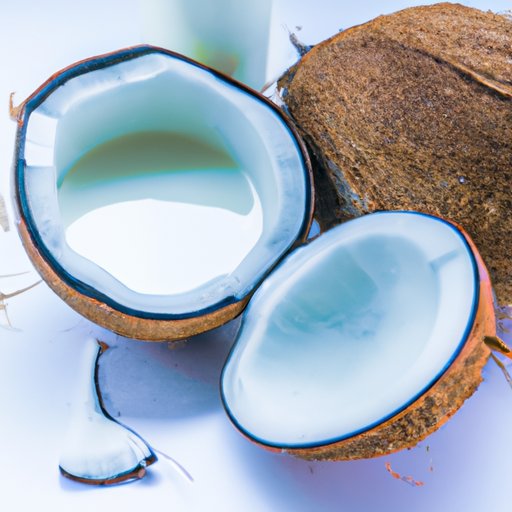
Introduction
Lactose intolerance is a common condition where people have difficulty digesting lactose, a sugar found in milk and dairy products. Symptoms can include bloating, gas, stomach cramps, diarrhea and nausea. If you are lactose intolerant, finding lactose-free alternatives is essential to maintaining a healthy diet and avoiding discomfort.
The Benefits of Coconut Milk
Coconut milk is a non-dairy, lactose-free milk alternative that has gained popularity among health-conscious consumers. It is made by blending grated coconut flesh with water and straining out the solids. Coconut milk has a creamy texture and a subtle sweet taste that works in a variety of dishes as a dairy replacement.
Coconut milk is also highly nutritious and packed with vitamins, minerals and antioxidants. It contains medium-chain triglycerides (MCTs), which are beneficial for weight loss, brain function and heart health. Coconut milk is also rich in lauric acid, a healthy fat that can boost immune function and reduce inflammation.
Compared to dairy milk, coconut milk has fewer calories and less cholesterol. It is also naturally lactose-free, making it an excellent option for people who are lactose intolerant.
When compared to other non-dairy alternatives, coconut milk stands out due to its consistency, nutritional value and versatility. While almond and soy milk are commonly used alternatives, coconut milk has a thicker consistency that works well in recipes such as curries, soups and smoothies.
Is Coconut Milk Lactose-Free?
Lactose is a type of sugar found in dairy products, but it is not present in coconut milk. As such, coconut milk is a lactose-free alternative to dairy milk. However, it is essential to check the label before purchasing, as some coconut milk products may have added sugars or thickeners that contain lactose.
Another aspect to consider when using coconut milk is the fat content. While coconut milk is rich in healthy fats, it is also high in calories. If you are watching your weight or are on a low-fat diet, it is recommended to use light coconut milk or coconut milk that has been diluted with water.
If you are looking for other lactose-free alternatives, there are several options available. Soy milk, almond milk, rice milk and oat milk are all widely available in many stores and come in a variety of flavors and styles.
Cooking with Coconut Milk
One of the advantages of coconut milk is its versatility in cooking and baking. It can be used as a milk substitute in recipes that call for dairy milk, and works well in both sweet and savory dishes.
When using coconut milk in cooking, it is important to select the right type that suits your needs. Light coconut milk has less fat and is suitable for thinner sauces, soups or smoothies. Regular canned coconut milk is thicker and higher in fat, making it suitable for richer sauces or desserts such as ice cream and custard.
Here are some tips for using coconut milk in your cooking and baking:
- Shake the can well before opening to blend the thick cream and liquid.
- For thicker cream, refrigerate the can overnight and scoop off the solid layer on top.
- When using in a soup or sauce, add coconut milk towards the end of the cooking process to avoid curdling or separating.
- For baking, use coconut milk that has been warmed to room temperature to avoid clumping.
Here are some lactose-free recipes that use coconut milk:
- Tom Kha Gai (Thai Coconut Soup)
- Vegan Coconut Curry
- Coconut Milk Smoothie
- Coconut Vanilla Ice Cream
- Coconut Milk Rice Pudding
Making Your Own Lactose-Free Coconut Milk
While coconut milk is readily available in stores, making your own coconut milk at home is a cost-effective and healthier option. All you need is grated coconut meat and water, a blender and a cheesecloth or nut milk bag.
Here is a step-by-step guide on how to make lactose-free coconut milk at home:
- Add 2 cups of grated coconut meat and 4 cups of water to a blender.
- Blend for 2-3 minutes on high, or until the mixture is smooth and creamy.
- Pour the mixture through a cheesecloth or nut milk bag into a bowl, squeezing out as much liquid as possible.
- Transfer the coconut milk to a sealed container and refrigerate up to four days.
Making coconut milk at home also allows you to customize the flavor and consistency to suit your preferences. You can experiment with blending in different fruits, spices or sweeteners for a unique taste.
Incorporating Lactose-Free Coconut Milk into Your Diet
Coconut milk can be used in a variety of ways, from sweet to savory, and is a great addition to any lactose-free diet. Here are some creative ways to use coconut milk in your everyday meals and snacks:
- As a milk substitute in cereal or smoothies
- As a base for sauces or soups
- In baking recipes for cakes or muffins
- As a creamer in coffee or tea
- As a topping for oatmeal or pancakes
Coconut milk is also commonly used in various ethnic cuisines, including Thai, Indian and Caribbean dishes. From curry to dessert, there are many recipes that can benefit from the rich and creamy texture of coconut milk.
Conclusion
Coconut milk is a delicious and nutritious lactose-free alternative to dairy milk. With its versatility and health benefits, it has become a popular choice among consumers who are looking for non-dairy options. Whether you’re using it in cooking, baking or as a creamer, coconut milk is a fantastic addition to a lactose-free diet. Try making your own at home, or experiment with the many recipes that use coconut milk as the main ingredient.




